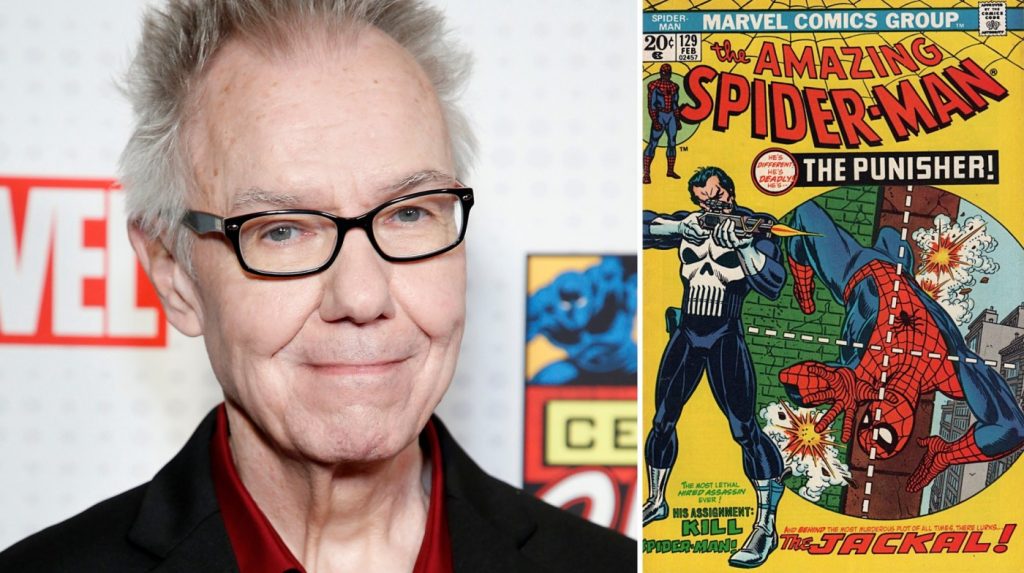The Punisher turns 50 this month.
Normally, when anybody turns 50, you want to congratulate them. But the Punisher outlived his welcome somewhere during the Reagan administration. He is an artifact of a time when Americans could still agree broadly on what was right or wrong, moral or criminal. He should have died decades ago, and yet there he is, every day, glowering.
Probably, you don’t know you’re looking at him. He’s cultural white noise to many and a cultural dog whistle to others. He stares at you from T-shirts and tattoos and, most noticeably, those little stickers on the backs of cars — or rather, typically, from the back windows of big trucks and SUVs. The bigger the wheels, the more likely it’ll have a Punisher sticker, looking super spooky and warning you without really saying anything.
The Punisher logo is a skull with four teeth jutting downward, like a dagger, or, as I like to think of it, a universal symbol of solidarity among people who only have four teeth.
The Punisher skull is a favored symbol among white nationalists, Proud Boys, terrorist groups and January 6 insurrectionists. It’s been found tattooed on mass shooters and would-be killers who were stopped before they could open fire. It’s also been adopted by members of the military — notably, Iraq veteran Chris Kyle, who bragged of spray-painting the skull across the Middle East in his memoir “American Sniper,” helping popularize it among front-liners — and for a long while, it’s been popular with some police, including Chicago police. A few years ago, Channel 2 CBS News reported that a Chicago officer wore a Punisher patch on his uniform during a 2019 Christmas Eve raid in which police forced their way into a home and pointed guns at the wrong kids. In 2017, a pair of Winnebago County deputies were ordered to stop handing out unofficial business cards with a Punisher logo. There are many similar examples, nationwide.
In fact, right now, you can buy a Punisher patch or pin for your uniform — the skull topped cleverly with a Trumpian wave of blonde hair — from the Chicago Cop Shop, a locally-based business specializing in custom Chicago police merchandise. The online shop for the Fraternal Order of Police Chicago Lodge # 7 has sold items with the logo, too — as have the gift shops of police (and fire) unions around the country, often with a thin blue line accenting the skull, to reinforce your support of law enforcement.
And that’s funny, or to be specific, stupid.
The Punisher, who debuted in Marvel Comics in 1974, hated cops. He was not a fan of the police or any military command. He was not a fan of authority. He was a morally ambiguous antihero, a traumatized Vietnam vet whose family was murdered by the mob then dedicated himself to hunting down the worst of the worst. He had no super powers, only a lot of guns, and however righteous he might have seemed, unlike the traditional superheroes who stood in his way, his favorite method of stopping bad guys was killing them. He was nihilistic, vigilante justice, borderline insane, a bully who detested bullies.
Yet he came to symbolize — in some later Marvel iterations, and as a fetish for the alt-right — a viable (and extrajudicial) system of law and order, by any means necessary.
He came to represent, ironically, a lack of moral ambiguity.
And you know who doesn’t like that?
Gerry Conway, who co-created the Punisher 50 years ago for Marvel, as a second-tier sorta-villain for Peter Parker to spar with in issue No. 129 of “The Amazing Spider-Man.”
“The Punisher was always about grey areas,” he said. “He was created as a moral in-between. You were meant to have an ambivalent attitude towards him. He was trying to do right but in the wrong way, which is a struggle a lot of people go through. And yet a lot of the people who embrace him now — militants, the darker side of police forces and military — these people never see grays. They see black and white. They think of him as simply righteous, and they don’t get it. The Punisher was saying justice failed and didn’t live up to his personal standards, so here he is. Which is a totally sociopathic attitude.”
At best, Conway imagines a misreading.
At worst, he sees the Punisher logo being co-opted by neo-fascists with oppressive aspirations. “Though fascism for some of these people involves far too much thinking.”
Conway is 72.
We spoke the other day. He said that he hadn’t been aware that the Punisher was turning 50 this month. He’d been in and out of hospitals lately, he said. He has pancreatic cancer and has had successful surgeries but also complications, rehab facilities. He thinks about what he’ll be remembered for. His comic book bona fides run deep: He wrote the famous “The Night Gwen Stacy Died” story that’s now a foundational part of Spider-Man lore. He wrote Justice League comics for eight years. He co-created the first Ms. Marvel, as well as the Man-Thing, and Killer Croc, Firestorm and the Werewolf by Night.
“But the Punisher, that’s what I’ll be known for,” he said, “so I have conflicted feelings.”
You would, too.
The Punisher has been the subject of three films and a Netflix series; he’s so inseparable from the lore of a much bigger character, Daredevil, he’s expected to return to TV later this year when Disney+ releases a rebooted “Daredevil” series. Conway said a great many Punisher fans tell him that they simply like the skull logo. It’s cool, tough.
Yet it’s also become a cultural lesson in unintended consequences.
Fifty years ago, Conway and late artists Ross Andru and John Romita Sr. — who designed the logo, working from a sketch by Conway — created the Punisher partly as a comment on the law-and-order mandates of the Nixon Administration and 1960s and ‘70s conservatives, fearful that cultural change, civil rights and police reforms were feeding violent crime. The Punisher fit neatly into the era’s love of vigilante-spoiltation, Don Pendleton’s “Executioner” novels, “Taxi Driver,” the “Dirty Harry” and “Death Wish” series, most of which had a nugget of ambiguity toward the sanity of their antiheroes. They were fantasies about justice without paperwork, personal rights or legal grays.
“A simple, quick view of justice had never been the goal,” Conway said, who grew up in New York, part of an Irish family that worked as day labors. “We hoped you could think of the Punisher as cool and admire him for being single-minded and having devotion to a cause but still distance yourself from his methods.” Conway’s always identified as liberal. In fact, he’s said many Punisher admirers he meets are “fans of color” who see the character as a path to justice they can’t receive from police; in 2020, he tried rallying artists to redesign and reclaim the Punisher logo as the symbol for Black Lives Matter.
The problem is, sometimes a logo transcends its origins.
Related Articles
New bookstore braves high rents and fire truck crashes to be part of Bay Area bookselling tradition
In ‘Rapper’s Deluxe,’ Todd Boyd explores 50 years of rap and hip-hop
How ‘Who’s Afraid of Virginia Woolf?’ became a classic film despite the odds
Librarians are now front-line crisis workers, managing homeless patrons, mental illness, book-banners
Fact and fiction merge in Bay Area police officer’s new novel
The skull was seen on ISIS sympathizers during an attack on Israel, police uniforms at George Floyd protests and at the white nationalist rally in Charlottesville. Last month, the FBI arrested a Florida man they hunted for three years; one way they identified him was because he was wearing a Punisher patch during the Jan. 6 insurrection in Washington. So it makes sense that Marvel Comics recently gave the Punisher a new logo, a similar skull augmented with devil horns, and even the character Frank Castle, who moonlighted for 50 years as the Punisher, was retired and replaced in November with a less deranged Punisher.
But there’s no getting some intellectual property back in the barn.
That old skull was bootlegged so ubiquitously its context is meaningless now. Then again, I’m not sure an antihero — a Batman, or Deadpool, or the titular characters of “The Boys” on Amazon Prime — has meaning in a world that can’t agree on the settings of its moral compass. An antihero only works when we can agree on right and wrong.
Funny enough, it’s the Punisher himself who once offered some clarity: In a 2019 comic, the character runs into a couple of cops who tell him that they believe in him, and that they “have this club — sorta more of a movement.” They show him the Punisher sticker on their cruiser. And the Punisher listens, only to pull the sticker off and tear it to pieces.
“I’ll say this once,” he tells them. “We’re not the same. You took an oath to uphold the law. You help people. I gave all that up a long time ago. You don’t do what I do.”
But offers them a better role model:
“His name is Captain America, and he’d be happy to have you.”


